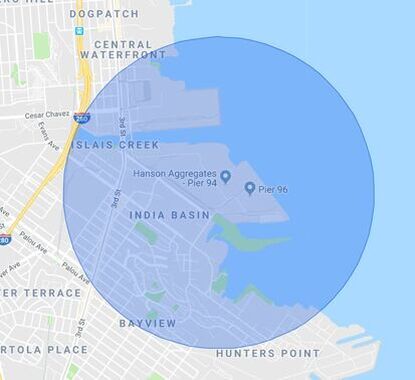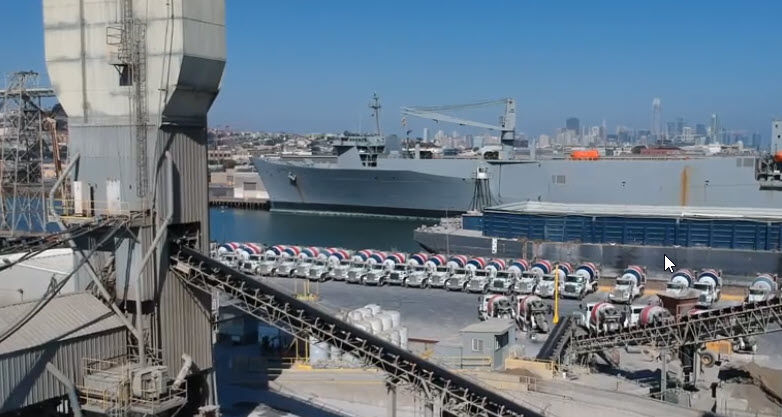Aggregates and Air Pollution
Cement Batching Plants Pier 92
Street Air is investigating air impacts from the concrete aggregate industry at piers 92-96 in San Francisco.
To make concrete, sand is mixed with cement and other materials and then dropped into trucks for delivery. During this process sand is released into the air, along with other materials associated with making concrete. Particulate emissions are also released from the diesel truck engines, and the trucks also kick up a considerable amount of dust by driving through the plant area. We call these emissions “AIRgregates”.
We decided to take air measurements around the batching plants to see what level of emissions are created on pier 92 and whether these particles can be affecting the nearby Bay Vew community.
In June, 2018 we took our first measurements as we surveyed the site. At the northern intersection to the pier, at an area removed from the pick-up and truck filling areas, our monitors showed that there was 77 micrograms per cubic meter of pm 2.5 in the air. Using the EPA standards, the air in this area would be considered “unhealthy for sensitive groups”. During a normal work day, our samples have shown that PM levels exceeded 140 micrograms per cubic meter of PM 2.5 particles in the central mixing plant area. This is considered ‘unhealthy air’ (borderline very unhealthy) by the EPA.
The Lancet (cited below) recently reported on a massive new study that shows PM materials can be contribute to diabetes. This study has motivated us to quantify the PM produced by the concreted mixing industry and how the PM disperses.
In our film we discuss how these emissions can be mitigated.
To make concrete, sand is mixed with cement and other materials and then dropped into trucks for delivery. During this process sand is released into the air, along with other materials associated with making concrete. Particulate emissions are also released from the diesel truck engines, and the trucks also kick up a considerable amount of dust by driving through the plant area. We call these emissions “AIRgregates”.
We decided to take air measurements around the batching plants to see what level of emissions are created on pier 92 and whether these particles can be affecting the nearby Bay Vew community.
In June, 2018 we took our first measurements as we surveyed the site. At the northern intersection to the pier, at an area removed from the pick-up and truck filling areas, our monitors showed that there was 77 micrograms per cubic meter of pm 2.5 in the air. Using the EPA standards, the air in this area would be considered “unhealthy for sensitive groups”. During a normal work day, our samples have shown that PM levels exceeded 140 micrograms per cubic meter of PM 2.5 particles in the central mixing plant area. This is considered ‘unhealthy air’ (borderline very unhealthy) by the EPA.
The Lancet (cited below) recently reported on a massive new study that shows PM materials can be contribute to diabetes. This study has motivated us to quantify the PM produced by the concreted mixing industry and how the PM disperses.
In our film we discuss how these emissions can be mitigated.
Location
Piesr 92-96
San Francisco, CA
San Francisco, CA
Site Plan for Aggregate/Construction Materials Area
CEMEX, Hanson Aggregates, and other aggregate materials businesses.
The aggregate industry has stated their belief that particles could not move south towards Bayview because the 'winds are from the west'. The graph above tells a story of wind variability and that during 36% of the year wind is from the north and towards Bayview.
----
HEALTH IMPACTS
From the New England Journal of Medicine:
"Increases of 10 μg per cubic meter in PM2.5 and of 10 ppb in ozone were associated with increases in all-cause mortality of 7.3% (95% confidence interval [CI], 7.1 to 7.5) and 1.1% (95% CI, 1.0 to 1.2), respectively. When the analysis was restricted to person-years with exposure to PM2.5 of less than 12 μg per cubic meter and ozone of less than 50 ppb, the same increases in PM2.5 and ozone were associated with increases in the risk of death of 13.6% (95% CI, 13.1 to 14.1) and 1.0% (95% CI, 0.9 to 1.1), respectively. For PM2.5, the risk of death among men, blacks, and people with Medicaid eligibility was higher than that in the rest of the population."
www.nejm.org/doi/full/10.1056/NEJMoa1702747h
From The Lancet
Massive Study Correlates PM 2.5 with Diabetes:
"Interpretation". "The global toll of diabetes attributable to PM2·5 air pollution is significant. Reduction in exposure will yield substantial health benefits."
https://www.thelancet.com/journals/lanplh/article/PIIS2542-5196(18)30140-2/fulltext
Street Air's Monitoring

Street Air is looking at small (PM 1 and PM 2.5) particulates in a radius of 1 mile and less. This will encompass city parks, an elementary school and residential areas in Bay View.
Street Air will be using PM1 and PM 2.5 monitors to sample smaller sized particles. Small particles are responsible for health issues and are often overlooked in sampling construction materials. Many people in the aggregate industry downplay possible impacts and cite their view that the aggregate industry generates PM 10 (large particles) not smaller PM 2.5.
We will also simultaneously monitor several sites to look for patterns, concentrations, and particulate dispersal routes
Contact Us
info@streetair.org



